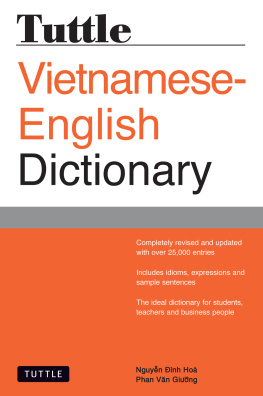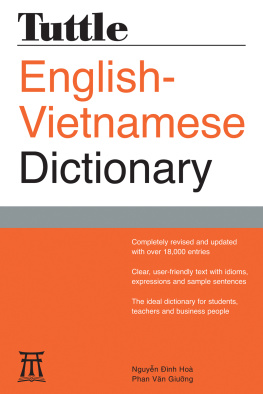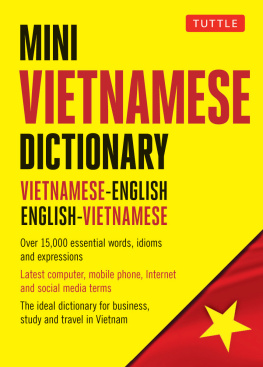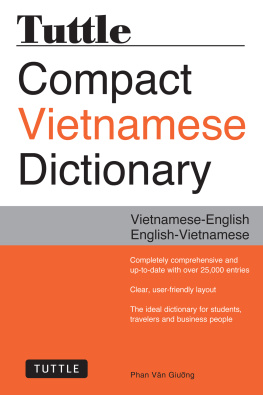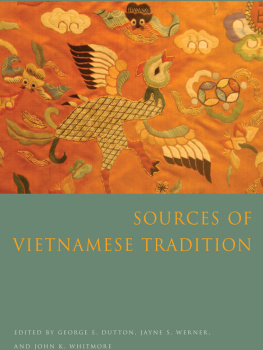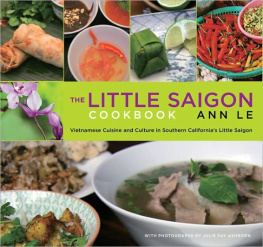Vit Nam
Ohio University Research in International Studies
This series of publications on Africa, Latin America, Southeast Asia, and Global and Comparative Studies is designed to present significant research, translation, and opinion to area specialists and to a wide community of persons interested in world affairs. The series is distributed worldwide. For more information, consult the Ohio University Press website, ohioswallow.com.
Books in the Ohio University Research in International Studies series are published by Ohio University Press in association with the Center for International Studies. The views expressed in individual volumes are those of the authors and should not be considered to represent the policies or beliefs of the Center for International Studies, Ohio University Press, or Ohio University.
Executive Editor: Gillian Berchowitz
Southeast Asia Series Editors: Elizabeth F. Collins and William H. Frederick
Vit Nam
Tradition and Change
Hu Ngc
Edited by Lady Borton and Elizabeth F. Collins
OHIO UNIVERSITY RESEARCH IN INTERNATIONAL STUDIES
SOUTHEAST ASIA SERIES NO. 128
OHIO UNIVERSITY PRESS
ATHENS
NH XUT BN TH GIIWORLD PUBLISHERS
H NI
Published by Ohio University Press, Athens, Ohio 45701
ohioswallow.com
All rights reserved
To obtain permission to quote, reprint, or otherwise reproduce or distribute material from Ohio University Press publications, please contact our rights and permissions department at (740) 5931154 or (740) 5934536 (fax).
Printed in the United States of America
Ohio University Press books are printed on acid-free paper 
Text copyright 2016 by Hu Ngc
Translations copyright 2016 by Hu Ngc and Lady Borton
Foreword copyright 2016 by Elizabeth F. Collins
Introduction, About the Vietnamese Language, A Chronology of Vietnamese History, Presentation of the Drawings, and Index copyright 2016 by Lady Borton
Henri Ogers Mechanics and Crafts of the Vietnamese People
copyright 2016 by Olivier Tessier
Cover photograph 2016 by Mary Pecaut
Cover design by Beth Pratt
26 25 24 23 22 21 20 19 18 17 16 5 4 3 2 1
Library of Congress Cataloging-in-Publication Data
Names: Hu Ngc, author. | Borton, Lady, editor. | Collins, Elizabeth Fuller, editor.
Title: Viet Nam : tradition and change / Huu Ngoc ; edited by Lady Borton and Elizabeth F. Collins.
Other titles: Research in international studies. Southeast Asia series ; no. 128.
Description: Athens, Ohio : Ohio University Press, [2016] | Series: Ohio University Research in International Studies Southeast Asia series ; no. 128 | Includes bibliographical references and index.
Identifiers: LCCN 2016016840| ISBN 9780896803015 (hc : alk. paper) | ISBN 9780896803022 (pb : alk. paper) | ISBN 9780896804937 (pdf)
Subjects: LCSH: VietnamCivilization. | VietnamSocial life and customs.
Classification: LCC DS556.42 .H877 2016 | DDC 959.7dc23
LC record available at https://lccn.loc.gov/2016016840
Table of Contents
by Elizabeth F. Collins
by Lady Borton
Foreword
Short, clear introductions to the cultures of Southeast Asian nations are difficult to find. For years, I cobbled together collections of short articles and selections of literature for my university-level introduction to Southeast Asia and presented the historical framework in lecture. My goal was to entice students to investigate the material on their own or in a more advanced class.
On a trip to Vit Nam, an area outside my own research field in the Bahasa world of Indonesia and Malaysia, I had a chance to meet Hu Ngc and was given a copy of Wandering through Vietnamese Culture, a collection of his essays, which is over 1,200 pages. It served as a wonderful guide, containing answers to so many of the questions that had presented themselves. When Ohio University Press was considering publication of an excerpted version of Wandering through Vietnamese Culture, I was asked in my role as editor for the O.U. Presss Southeast Asia Series to accept the Presss invitation to make the initial selection of essays.
Hu Ngc originally wrote his essays as newspaper columns for international readers who, living in Vit Nam, had some acquaintance with the country. Yet all of us working on this project, including and especially Hu Ngc, wanted also to think of those for whom Vit Nam is completely new. Starting from an early draft Table of Contents, with Hu Ngc as expert and author, we worked together to crystallize his oeuvre into a first-taste introduction to Vietnamese history and culture, emphasizing the structure, factors, and individuals he feels are particularly important.
Vit Nam: Tradition and Change shimmers with Hu Ngcs thoughtful reflections and insight. The collection is designed for students in introductory classes and for other readers interested in Vit Nam. I hope they will also fall in love with the rich cultural heritage of the people and nation that is Vit Nam.
Hu Ngcs central thesisAll tradition is change through acculturationtwines through each of the books ten sections and through many of these short essays. In the first section, The Vietnamese Identity, Hu Ngc portrays what it means to be Vietnamese. He describes the values that shape Vietnamese character, such as the untranslatable word ngha, and explores the meaning of the customs that embody Vietnamese ideals: ancestor veneration, worship of mother goddesses, the naming of a child, the arrangement of a traditional Vietnamese house, and the deep emotional attachment Vietnamese have to the communal houses of their home villages. In encounters with othersthe Chinese, French, Japanese, and American overlords who have tried to rule Vit Namthe Vietnamese absorbed new values, translating them into their own Vietnamese vernacular. Hu Ngc shows that the Vietnamese are martial, but not militaristic; they are willing to fight to defend their nation but never forget the anguish that war brings. We see how the Vietnamese have blended their ancient Austronesian cultural heritage and language together with Buddhist traditions brought from India and China, with the value that Confucian ethics from China place on order, harmony, and scholarly learning, and then with the Western influence of humanism and individual liberty. Nevertheless, for Hu Ngc, Buddhism remains the heart of the Vietnamese village, while Confucian ethics and learning and rites are still its head. The ancient, quintessentially Vietnamese rites of ancestor veneration that bind a family, clan, and village together and the awe at the legendary powers of the spirits of nature as well as the spirits of national and local heroes are the roots that anchor Vit Nam today.
The second section, The Four Facets of Vietnamese Culture, illuminates how the ancient Vit (Kinh) ethnic group had its roots in Southeast Asia and defines the Vits earliest cultural descriptors (e.g., a wet-rice-growing culture and bronze drums) that Vit Nam shares with other Southeast Asian countries. However, Hu Ngc specifies the cultural aspects (e.g., matriarchy, mother goddesses, myths, and legends) that are quintessentially Vietnamese. He clarifies the four major facets of Vietnamese culturethe original Southeast Asian roots and the subsequent Indian-Chinese, French, and regional-global branchesand shows how the Southeast Asian base of Vietnamese culture persists today within a dynamism created by tradition and change through acculturation. Central to the features specific to Vit Nam and important in the Vits preservation of their cultural essence during foreign occupations is the Vietnamese language. Vietnamese has been the mother tongue of the Vit for millennia and, today, is the mother tongue for 85 percent of the countrys population, which includes fifty-four ethnic groups. Many nations, particularly former colonies in Africa and Asia, do not have this unifying feature of a common language, which is both ancient and modern.
Next page


